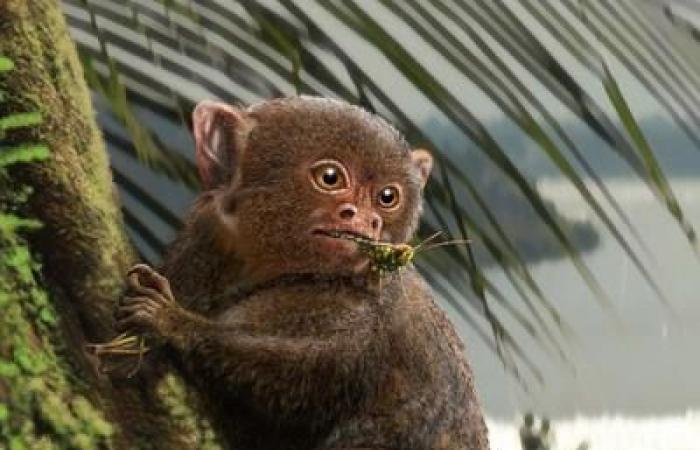For decades, paleontologists have been trying to know how primates have managed to reach South America. Araigned monkeys, Capuchins and Ouistitis of the continent are indeed their own group of primates, distinct from those of Africa and Asia. The ancestors of these species would, according to the most widespread theory, crossed the Atlantic Ocean aboard rafts 40 to 32 million years ago.
The discovery of new fossils indicates, however, that their dispersion may well have been much more complex. South America actually housed a wider range of primates than specialists thought, which suggests that, during a key period of prehistoric times, violent storms would have caused the detachment of vegetation carpets on which were in particular monkeys, thus causing the latter in a most improbable transatlantic journey … and which would have taken place at least two times.
A tiny fossil tooth, discovered in rocks of the Brazilian Amazon, is one of the most recent evidence of the existence of these prehistoric maritime trips. “When one of my Brazilian colleagues showed me this tiny tooth, my heart was immediately packed,” said Laurent Marivaux, paleontologist at the University of Montpellier. The 34 million year old tooth described by Marivaux and his colleagues in an article published in the journal Proceedings of the National Academy of Sciences (PNAS), does not seem to belong to a South American monkey, but rather to an individual belonging to a family extinct of primates from South Asia, known asEosimiidae.
It is not the first time that a strange animal has appeared in prehistoric South America. In 2020, the paleontologist Erik Seiffert and his colleagues announced the discovery in Peru of a sort of monkey called Ucayalipithecuswhich had ancestral ties not with the modern South American line, but with ancient Africa. The primates therefore had to make the trip from Africa to South America at least twice, and according to some specialists, the new tooth could indicate that a third group would also have made such a crossing.
Baptized Ashaninkacebus Simpsons By Marivaux and his colleagues, this new fossil primate is only known thanks to a single upper molar found along the Rio Juruá, in Brazil. The disposition of cuspids on the tooth makes it possible to determine that its owner was a primate, potentially of the family of Eosimiidae. Based on other fossils ofEosimiidae discovered in the past, scientists think thatAshaninkacebus was a small animal, the size of a common Ouistiti, which weighed around 200 grams and was mainly fed by insects and fruit.
Although the molar belongs to a primate, other specialists are not entirely sure of its origins. THE Eosimiidae were present in Africa and Asia, “therefore, this discovery constitutes a new example of a primitive line from Africa which appeared in South America,” explains Mary Silcox, paleontologist at the University of Toronto, who was not involved in the new study.
And Ashaninkacebus is indeed a Eosimiidaehe would then be the third group of primates to have moved between the continents. This is not the only possibility: another theory connects the new discovery to the monkeys that are living in South America Today, known as Platyrrhiniens.
“I suspect Ashaninkacebus to be a [groupe-souche] De Playyrrhinien, ”says Erik Seiffert, paleontologist at the University of Southern California, who did not participate in the new study. Thus, rather than representing a group of primates who would have arrived in South America and which would then have disappeared, the molar could actually belong to the first ancestors of the monkeys of the continent. “If this is the case, then there would have been only two dispersion events. »»
ThatAshaninkacebus Either one of the first Platyrrhinians or a completely distinct group, specialists still have to discover how animals have managed to move from one continent to another, and this on several occasions.
“All our hypotheses and all our scenarios are based on our knowledge of the fossil register,” explains Marivaux. Since the 1970s, paleontologists have been wondering if primates would not have crossed the Atlantic on floating vegetation rafts. No other explanation seems plausible, because no land then connected South America and Africa, and because nothing indicates that the primates have taken another earthly route.
-In addition, the latter were not the only animals to participate in this unexpected trip. Paleontologists have discovered that the ancestors of the Capybaras and other rodents, called Hystricognathes, were probably also dispersed from Africa to South America.
It seems almost impossible to survive a continent crossing on a mass of vegetation. This is why scientists tried to determine if the rodents and the monkeys had traveled on the same bed of tangled plants, or if this dispersion had taken place in several times.
It is practically impossible to resolve this enigma using direct fossil evidence. However, after having reconstructed the continents, currents and climates of the world at the time of the arrival of primates in South America, Marivaux and his colleagues suggest that, during a brief period, the conditions were ideal to allow mammals “to embark against their will” in a long journey towards another continent.
The first primates of South America were small and fed on fruit, which suggests that their ancestors lived in humid forests along the west coast of Africa, about 40.5 million years ago. The animals that lived near the deltas and river networks were more likely to be swept away by the floods, and therefore to cling to the parts of trees which were detached and of being carried away by the sea.
This speculative scenario is not a simple conjecture, and is not specific to the South American monkeys either. Lemurs and tenrecs have also arrived in Madagascar from continental Africa on board natural rafts, as are species of small lizards, which were thus able to travel through the Bahamas.
“An entire ecosystem can move on these pieces of banks,” describes Marivaux. Today, vegetation rafts can be very large, some of them can even cause trees that still bear fruit. Many primates and rodents who lived along the coasts of prehistoric Africa lived in areas likely to create, during large storms, such rafts capable of transporting them to these long distances.
According to the new study, these crossings took place around 40.5 million years ago, when South America and Africa were only separated by a distance of around 1,000 km, which is much shorter than the current 2,900 km.
To Seiffert, this date could be later. About 33 million years ago, sea level fell, reducing this distance. “Significant erosion in the environments close to the shore could also have led to the detachment of these large rafts,” he offers.
Future fossil discoveries will help elucidate this mystery, but they will probably prove to be difficult. “The fossils found in this part of the Amazon are mainly isolated teeth, due to the method that must be used to collect them,” reveals Seiffert. Researchers often take whole sediment shovels from tilted banks and wash them in water, a process that allows you to separate the teeth and bones from the earth and rock. Unfortunately, sometimes the small bones are destroyed and that only the teeth, stronger, are preserved.
The discovery of three primitive South American primates since 2015 nevertheless indicates that the future could give rise to new details on the events that have led animals to South America. “Ten years ago, we would not have believed it,” concludes Marivaux.








